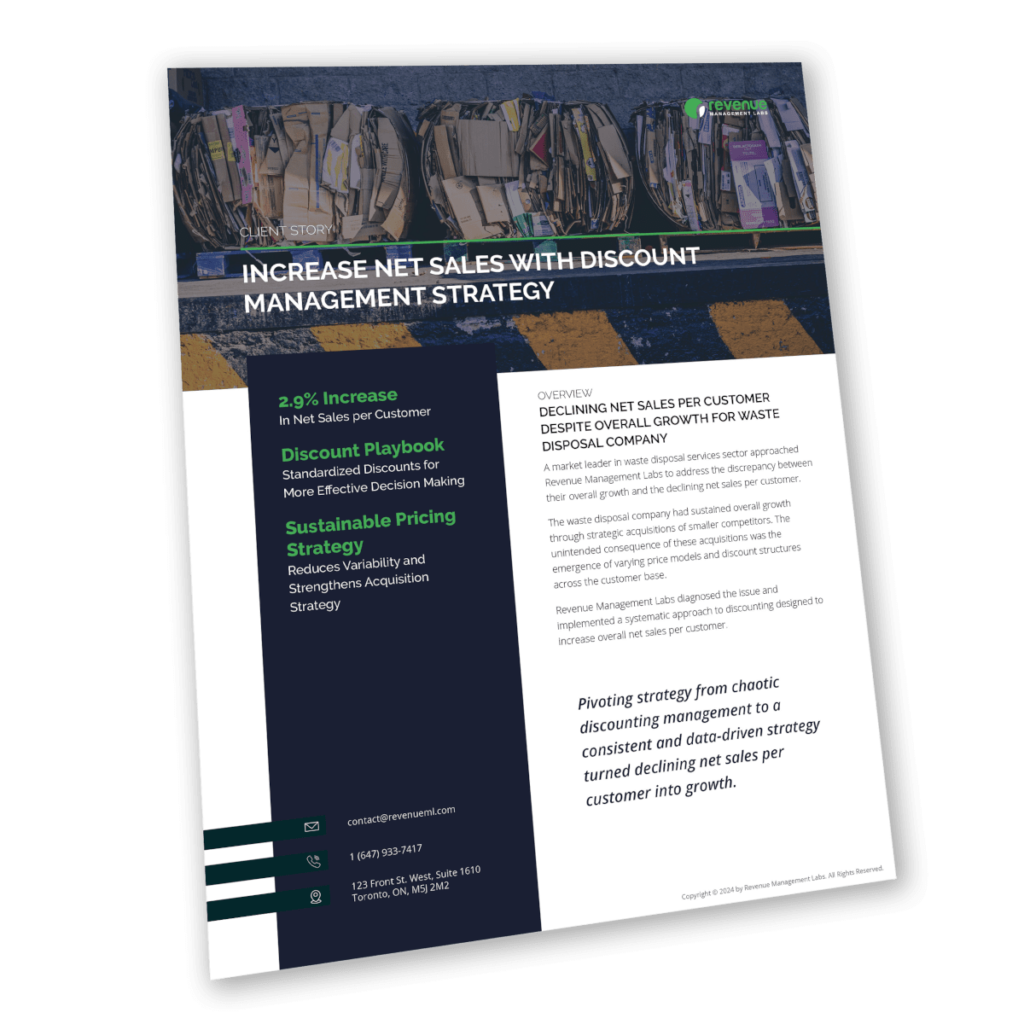Pivoting strategy from chaotic discounting management to a consistent and data-driven strategy turned declining net sales per customer into growth.
A market leader in waste disposal services sector approached Revenue Management Labs to address the discrepancy between their overall growth and the declining net sales per customer.
The waste disposal company had sustained overall growth through strategic acquisitions of smaller competitors. The unintended consequence of these acquisitions was the emergence of varying price models and discount structures across the customer base.
Revenue Management Labs diagnosed the issue and implemented a systematic approach to discounting designed to increase overall net sales per customer.
One of the primary challenges faced by the waste disposal company revolved around the significant disparities in the discount structures for newly acquired companies. This inconsistency resulted in similar, longstanding customers receiving markedly different discount rates. The lack of uniformity in discount allocation posed a critical issue in maintaining fairness and transparency across the customer base.
Compounding the challenge of disparate discount structures were substantial price increases implemented to counter the declining net sales. These increases triggered a surge in customer complaints as clients voiced their dissatisfaction with the elevated pricing. The escalation of customer concerns necessitated frequent interactions with support staff, creating operational strain and triggering ad hoc negotiations for one-off discounts.
In Net Sales per Customer
Standardized Discounts for More Effective Decision Making
Reduces Variability and Strengthens Acquisition Strategy

Revenue Management Labs collaborated closely with the waste disposal company’s sales force and customer service team to formulate actionable strategies for the implementation of structured trade terms. This involved a comprehensive examination of existing discount types and their success rates, leading to the development of a tool designed to identify optimal discount types and apply them accurately to individual customers.
To further enhance efficiency and accuracy, a model for incoming customers was instituted. This model automatically flagged the permissible pricing levels based on the forecasted Customer Lifetime Value (CLV) of incoming customers. This not only streamlined the onboarding process but also ensured that pricing aligns with the potential value of each customer, fostering a balanced and fair discounting approach.
Central to the solution was the commitment to maintaining the integrity of the discounting system. Rigorous measures were put in place to safeguard against inconsistencies, ensuring that the new structured trade terms were implemented uniformly and adhered to across the customer base.
Revenue Management Labs aimed to establish a clear Structured Pricing and Trade Terms (SPTT) framework, aligning discount strategies with customer value. This process began by clearly defining discount components through a consistent classification of trade spend and potential trade groups, laying the groundwork for the pricing structure. With a comprehensive view of client investments, the focus shifted towards understanding the relative return on investment from each of the discount types. The final step involved calculating the Customer Lifetime Value (CLV) to tailor discounts based on customer value, ensuring a personalized and targeted approach to pricing. This approach allowed for optimizing spend based on the customers with the highest lifetime value.
For a detailed review of the pricing methodology and data analysis,
download the full case study on discount management for waste management companies.
The implementation of the refined pricing strategy, anchored by the Structured Pricing and Trade Terms (SPTT) framework, yielded substantial positive outcomes for the waste disposal company. Post-project analysis revealed a remarkable 2.9% increase in Net Sales per customer year over year.
By defining clear discount components and structuring trade terms based on Customer Lifetime Value (CLV), the company achieved greater consistency and predictability in its pricing model. The reduction in variability and the personalized approach ensured that customers received discounts commensurate with their value, fostering positive relationships and loyalty.
The strategic alignment of discount structures, driven by a systematic understanding of customer value and a tailored approach through the discount playbook, played a pivotal role in the observed growth. This result underscored the effectiveness of the implemented pricing strategy in optimizing revenue performance.
We are here to help you achieve profitable revenue growth

We will cover the full results from our 2024 Executive Pricing Survey. See how you compare to your competitors both in past performance and for 2024 pricing strategy.